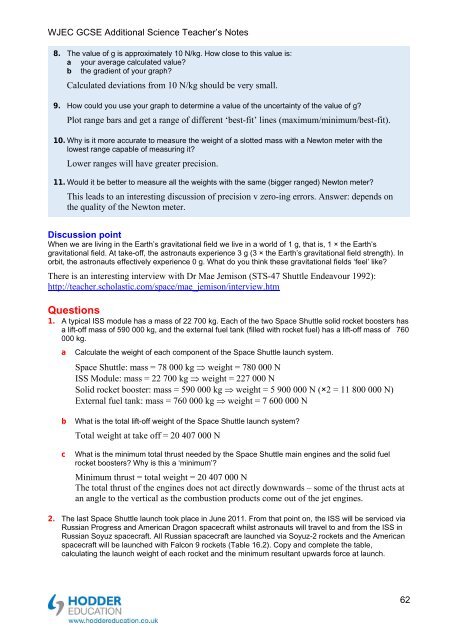Teacher's notes and answers to questions in the book - Hodder Plus ...
Teacher's notes and answers to questions in the book - Hodder Plus ...
Teacher's notes and answers to questions in the book - Hodder Plus ...
Create successful ePaper yourself
Turn your PDF publications into a flip-book with our unique Google optimized e-Paper software.
WJEC GCSE Additional Science Teacher’s Notes<br />
8. The value of g is approximately 10 N/kg. How close <strong>to</strong> this value is:<br />
a your average calculated value<br />
b <strong>the</strong> gradient of your graph<br />
Calculated deviations from 10 N/kg should be very small.<br />
9. How could you use your graph <strong>to</strong> determ<strong>in</strong>e a value of <strong>the</strong> uncerta<strong>in</strong>ty of <strong>the</strong> value of g<br />
Plot range bars <strong>and</strong> get a range of different ‘best-fit’ l<strong>in</strong>es (maximum/m<strong>in</strong>imum/best-fit).<br />
10. Why is it more accurate <strong>to</strong> measure <strong>the</strong> weight of a slotted mass with a New<strong>to</strong>n meter with <strong>the</strong><br />
lowest range capable of measur<strong>in</strong>g it<br />
Lower ranges will have greater precision.<br />
11. Would it be better <strong>to</strong> measure all <strong>the</strong> weights with <strong>the</strong> same (bigger ranged) New<strong>to</strong>n meter<br />
This leads <strong>to</strong> an <strong>in</strong>terest<strong>in</strong>g discussion of precision v zero-<strong>in</strong>g errors. Answer: depends on<br />
<strong>the</strong> quality of <strong>the</strong> New<strong>to</strong>n meter.<br />
Discussion po<strong>in</strong>t<br />
When we are liv<strong>in</strong>g <strong>in</strong> <strong>the</strong> Earth’s gravitational field we live <strong>in</strong> a world of 1 g, that is, 1 × <strong>the</strong> Earth’s<br />
gravitational field. At take-off, <strong>the</strong> astronauts experience 3 g (3 × <strong>the</strong> Earth’s gravitational field strength). In<br />
orbit, <strong>the</strong> astronauts effectively experience 0 g. What do you th<strong>in</strong>k <strong>the</strong>se gravitational fields ‘feel’ like<br />
There is an <strong>in</strong>terest<strong>in</strong>g <strong>in</strong>terview with Dr Mae Jemison (STS-47 Shuttle Endeavour 1992):<br />
http://teacher.scholastic.com/space/mae_jemison/<strong>in</strong>terview.htm<br />
Questions<br />
1. A typical ISS module has a mass of 22 700 kg. Each of <strong>the</strong> two Space Shuttle solid rocket boosters has<br />
a lift-off mass of 590 000 kg, <strong>and</strong> <strong>the</strong> external fuel tank (filled with rocket fuel) has a lift-off mass of 760<br />
000 kg.<br />
a Calculate <strong>the</strong> weight of each component of <strong>the</strong> Space Shuttle launch system.<br />
Space Shuttle: mass = 78 000 kg weight = 780 000 N<br />
ISS Module: mass = 22 700 kg weight = 227 000 N<br />
Solid rocket booster: mass = 590 000 kg weight = 5 900 000 N (×2 = 11 800 000 N)<br />
External fuel tank: mass = 760 000 kg weight = 7 600 000 N<br />
b What is <strong>the</strong> <strong>to</strong>tal lift-off weight of <strong>the</strong> Space Shuttle launch system<br />
Total weight at take off = 20 407 000 N<br />
c<br />
What is <strong>the</strong> m<strong>in</strong>imum <strong>to</strong>tal thrust needed by <strong>the</strong> Space Shuttle ma<strong>in</strong> eng<strong>in</strong>es <strong>and</strong> <strong>the</strong> solid fuel<br />
rocket boosters Why is this a ‘m<strong>in</strong>imum’<br />
M<strong>in</strong>imum thrust = <strong>to</strong>tal weight = 20 407 000 N<br />
The <strong>to</strong>tal thrust of <strong>the</strong> eng<strong>in</strong>es does not act directly downwards – some of <strong>the</strong> thrust acts at<br />
an angle <strong>to</strong> <strong>the</strong> vertical as <strong>the</strong> combustion products come out of <strong>the</strong> jet eng<strong>in</strong>es.<br />
2. The last Space Shuttle launch <strong>to</strong>ok place <strong>in</strong> June 2011. From that po<strong>in</strong>t on, <strong>the</strong> ISS will be serviced via<br />
Russian Progress <strong>and</strong> American Dragon spacecraft whilst astronauts will travel <strong>to</strong> <strong>and</strong> from <strong>the</strong> ISS <strong>in</strong><br />
Russian Soyuz spacecraft. All Russian spacecraft are launched via Soyuz-2 rockets <strong>and</strong> <strong>the</strong> American<br />
spacecraft will be launched with Falcon 9 rockets (Table 16.2). Copy <strong>and</strong> complete <strong>the</strong> table,<br />
calculat<strong>in</strong>g <strong>the</strong> launch weight of each rocket <strong>and</strong> <strong>the</strong> m<strong>in</strong>imum resultant upwards force at launch.<br />
62

















